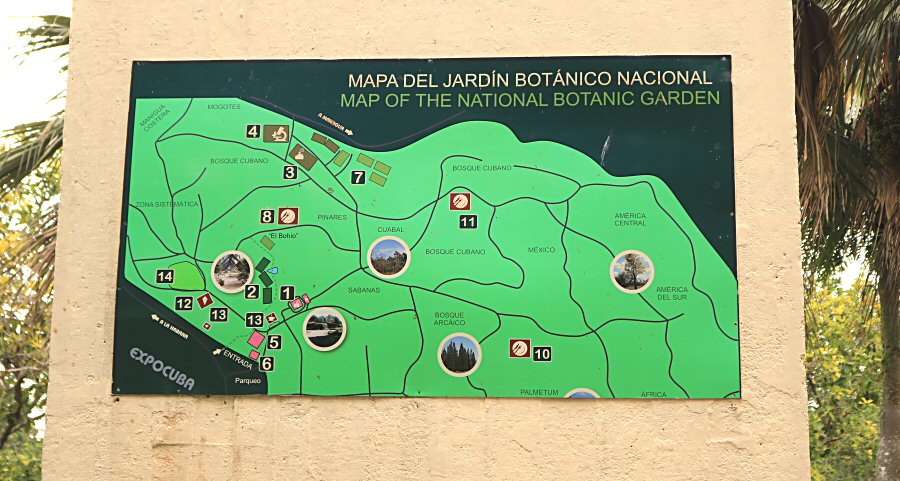The
Systematic Zone was conceived as a gigantic tree
composed of a network of pedestrian paths along which plant
families are distributed.
The
Ornamental Zone surrounds the main buildings (pavilions,
main entrance) and brings together a collection of trees,
shrubs and herbaceous plants with outstanding ornamental
value.
The
Cultivated Plants Zone is a collection of plants that
humans have used throughout history. Fruit trees and
short-cycle plants (vegetables, grains, and tubers) that are
used in the National Botanical Garden itself are
represented.
A special section of the National Botanical Garden is the
Indoor Scientific Collection Nursery. This area consists of
six shade houses and two glass naves, which house the core
collection of species with extreme humidity and full sun
requirements, cared for by specialized gardeners. The area
is under the scientific care of botanists.
The garden also includes special collections, such as
archaic forest, palmetum, scientific collection, Ekman
collection, Martian forest and economic plants (ethnobotanical
collection).
The very interesting
Archaic Forest brings together the
primitive species, present-day representatives of remote
flora, specifically from the Mesozoic (135 million years
ago), among which conifers, cyadae, and the earliest
flowering plants recreate the proposed environment.
The
Palmeteum houses over 250 varieties of palm trees,
approximately 90 of which are native to Cuba. This is the
largest collection of palm trees in the world.
It is useful to know some of the special collections in the
National Botanical Garden. For example, the
Ethnobotanical
Collection is dedicated to the memory of Dr. Juan Tomás Roig
y MesaThe eminent Cuban botanist who dedicated much of his
life to the study of plants useful to the humanity,
Ethnobotany is the science that studies the close
relationship between humanity and plants, which are used for
food, medicine, clothing, shelter, and other services. It is
closely related to the customs and culture of the native
peoples of each country.
Close to the entrance of the exhibition pavilions there is
the
Ekman Corner, dedicated to the memory of Erik Leonerd
Ekman, the renowned Swedish scientist who had a profound
knowledge about Cuban flora. He collected and discovered
numerous new species and climbed the highest mountains,
including the Turquino mountain range. Plants dedicated to
Ekman or species he collected and described are planted in
this corner.
Another interesting collection is located in the
Martí
Forest which you can encounter in the surroundings of the
socio-administrative building, and next to the bust of José Martí. It is part of the Cuban semi-deciduous forest in the
botanical garden. To select the species to be planted in
this area, José Martí's Campaign Diary from Playitas to Dos
Ríos was reviewed, written between April 11, 1895, the date
of his arrival at Playitas de Cajobabo, and May 16 of the
same year. In this Diary, Martí only mentioned the species
that most caught his attention, regardless of whether there
were other trees in the forest. In the selected area in the
National Botanical Garden, there were adult trees of the
Cuban forest, some mentioned in the Diary and others not, so
it was decided to leave them and begin planting the
mentioned species that were not available. Since 1996, the
tree and shrub species listed by Martí have been planted.
All plants are identified with a label, which includes the
scientific name, common name, and family. In the case of the
species Martí referred to directly, they also have a sign
with the commentary.
The
Herbarium wich is the second in Cuba, contains more
200,000 specimens of Cuban flora, distributed in various
plant groups. It covers the national area also with some
exotic collections from Mexico, French Guiana, Ecuador,
Spain, Germany, Puerto Rico, Dominican Republic, Brazil,
Venezuela, Virgin Islands and Florida (USA). Its fundamental
objective is to preserve the collection that serves as the
basis for the studies carried out for the publication "Flora
of the Republic of Cuba" and for the understanding of
biodiversity. The herbarium of the old Botanical Garden of
Havana, located in the Quinta de los Molinos, was the
nucleus from which the accelerated development of botanical
collecting in the country began. Its foundation dates back
to 1902.
To date, 120 bird species have been recorded at the National
Botanical Garden. Eight of these are endemic to Cuba and 12
to the Caribbean. At least 34 species nest in the garden.
However, four of the bird species living in the garden are
endangered and listed on Cuba's Red List of Endangered
Vertebrates.
Another 70 bird species are migratory. Most of these come
from North America and, like the warbler, spend the winter
in the tropics. Other species, such as the Honey Buzzard,
which comes to Cuba only to breed in the summer, originate
from South America.
Due to the attractiveness of its birdlife, the National
Botanical Garden is now a prominent place for birdwatching,
as birdwatching is a very relaxing and educational hobby
that allows one to enjoy nature and promotes knowledge and
conservation.
The construction and opening of new attractions, including a
canopy tour—the first in Havana—a mountain bike trail, a
ropes park, and a climbing route in the Mogotes area, are
increasing the number of recreational options at the
National Botanical Garden.

